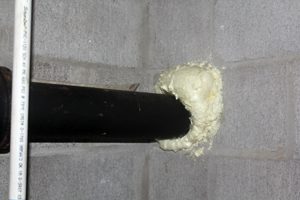Often pipes and shower heads which run through walls or tiles are installed incorrectly or eventually work themselves loose. The hole drilled for them to run through is too big and they continually vibrate due to the water running through them. This is an easy way to secure the pipe or shower head and keep it from moving. The expansion foam is also flexible so it allows some movement of the pipe due to thermal expansion.
If your shower head is starting to look old or dated, you may want to consider replacing it, follow our easy guide to replacing a shower head.
If your shower door is leaking or leaving puddles on your bathroom floor, have a look at this guide on how to replace your shower door seals.
What You Will Need To Secure The Shower Head or Pipe
- Expansion Foam (The DIY in a can type is perfect) – Buy Here
- Masking Tape – Buy Here
- Screwdriver or Pliers – Buy Plumbing Pliers Here
When buying the expansion foam for this repair, buy the smallest one possible. This job doesn’t require much foam and the left over foam doesn’t keep well. Also make sure that you get one with a small length of pipe after the nozzle, this is used to direct the foam into the joint.
How To Secure The Loose Shower Head
Pull the trim ring away from the wall, you may need to use pliers or a screwdriver to loosen it. The shower head or pipe should now be protruding through a hole in the wall. Often this hole is cut too big or has become too big through the movement of the shower head. Apply some masking tape to the wall around the hole to catch any excess expansion foam. Insert the expansion foam pipe into the hole around the pipe and squirt so that a ring of expansion foam forms around the pipe. The ring should surround the pipe entirely and should protrude a bit from the wall to provide additional support.
Wait for the expansion foam to cure before trimming the excess away. Only trim away what is necessary to fit the trim ring back on, the more foam you leave behind, the better the support will be. Push the trim ring back into place and the pipe or shower head should now be secure and movement free.
Was this helpful? Have you used any other method to secure a loose pipe or shower head? Let us know in the comments section below.



Thanks so much! We just moved into an apartment we love, but one that is also very old! At first I thought the arm or flange around it needed to be replaced (which they do) but until I saw this I wouldn’t have even known the actual pipe behind the wall was loose! It’s amazing the rabbit hole we go down as DIYers, but at least we know we are handy and can build ourselves a ladder to get out lolol.
Thanks again!
Hey Lisa,
Congrats on your new place, that’s great! It can be a bit overwhelming when you first move in, but fixing up and old place is part of the adventure. Good luck!
My shower head came out of the wall the hole is too big how do I fix it I’m a senior citizen on a fixed income.
Hahaha!!!
I know this is probably three years late but maybe it can help someone else. I have seen a link on YouTube for a quick way to fix this which I am currently trying. They measured the arm pipe and drilled a hole in the middle of a self-adhesive plastic wall protector (think the round flat pieces of plastic they put where a doorknob would hit to prevent damage) then slid the arm through and attached to the wall using the self adhesive. Covers the large hole and gives a little extra support too.